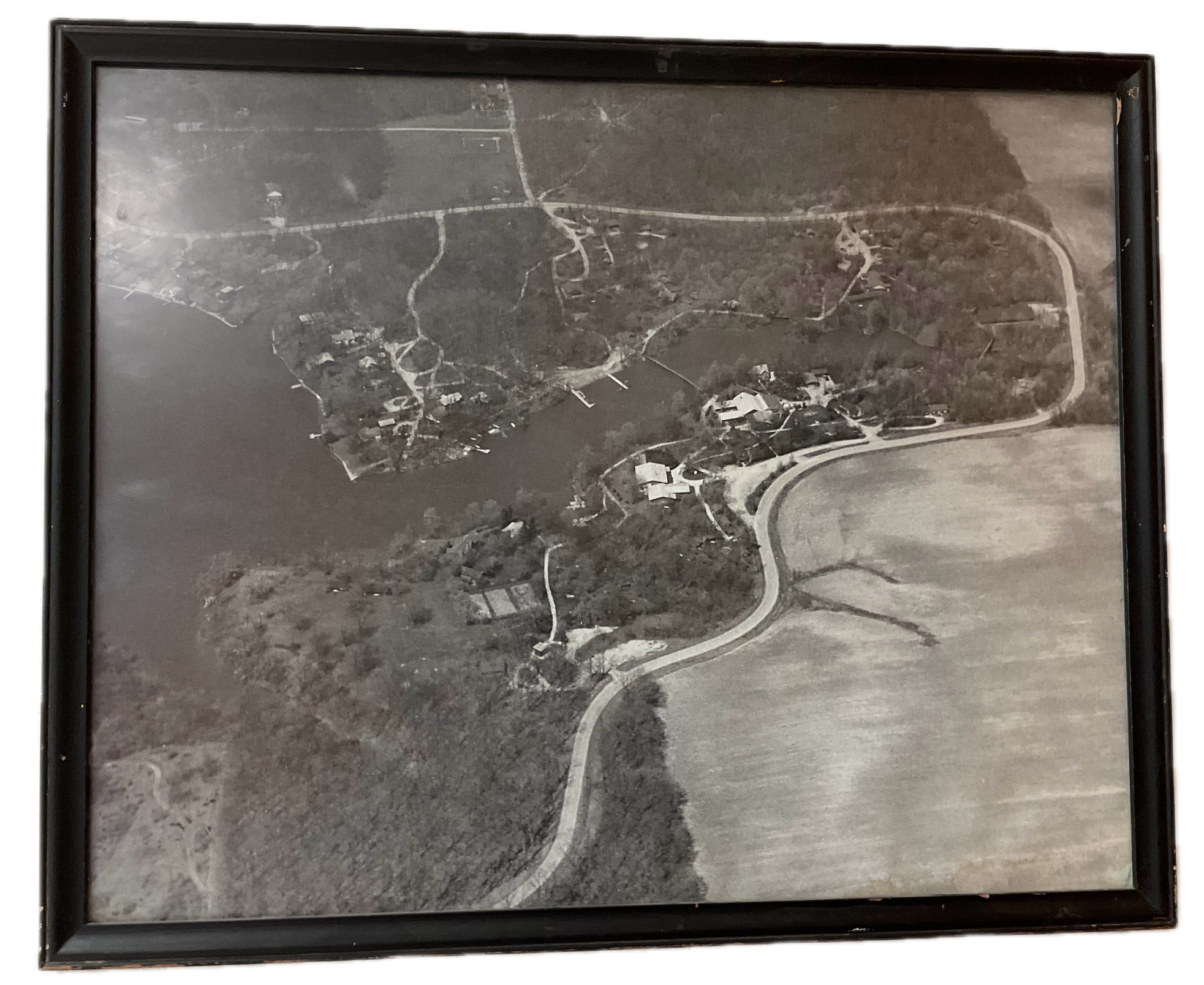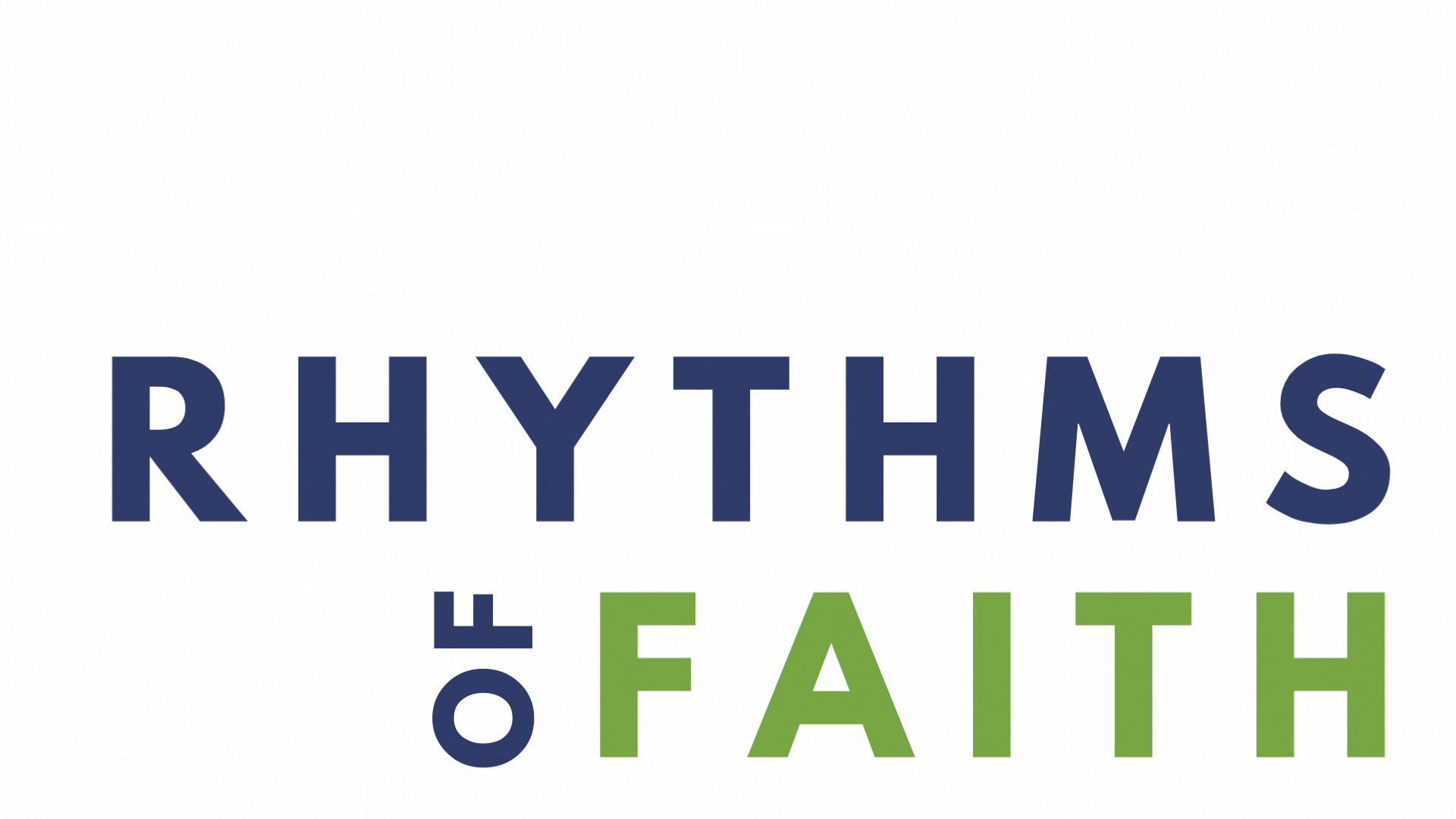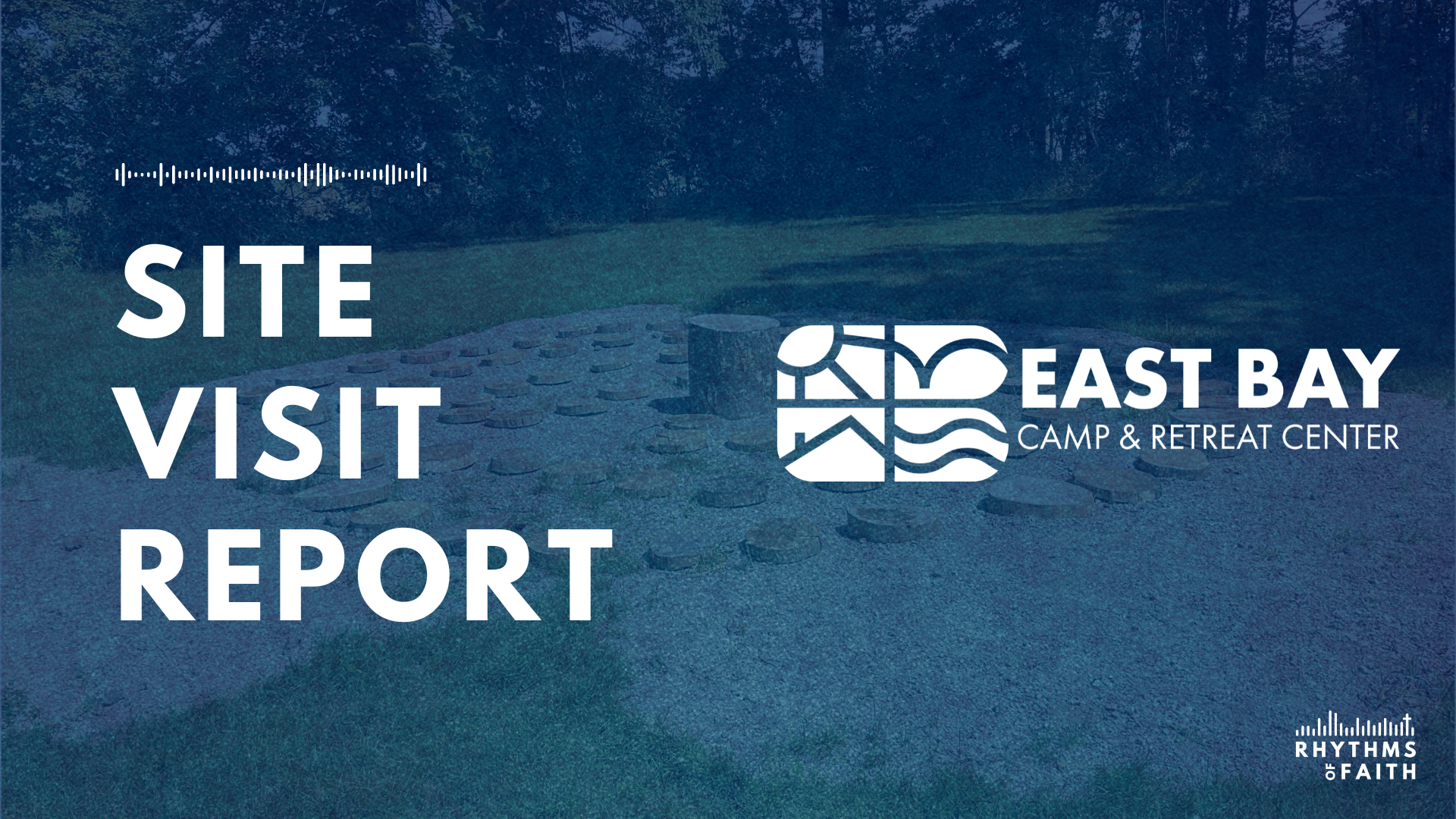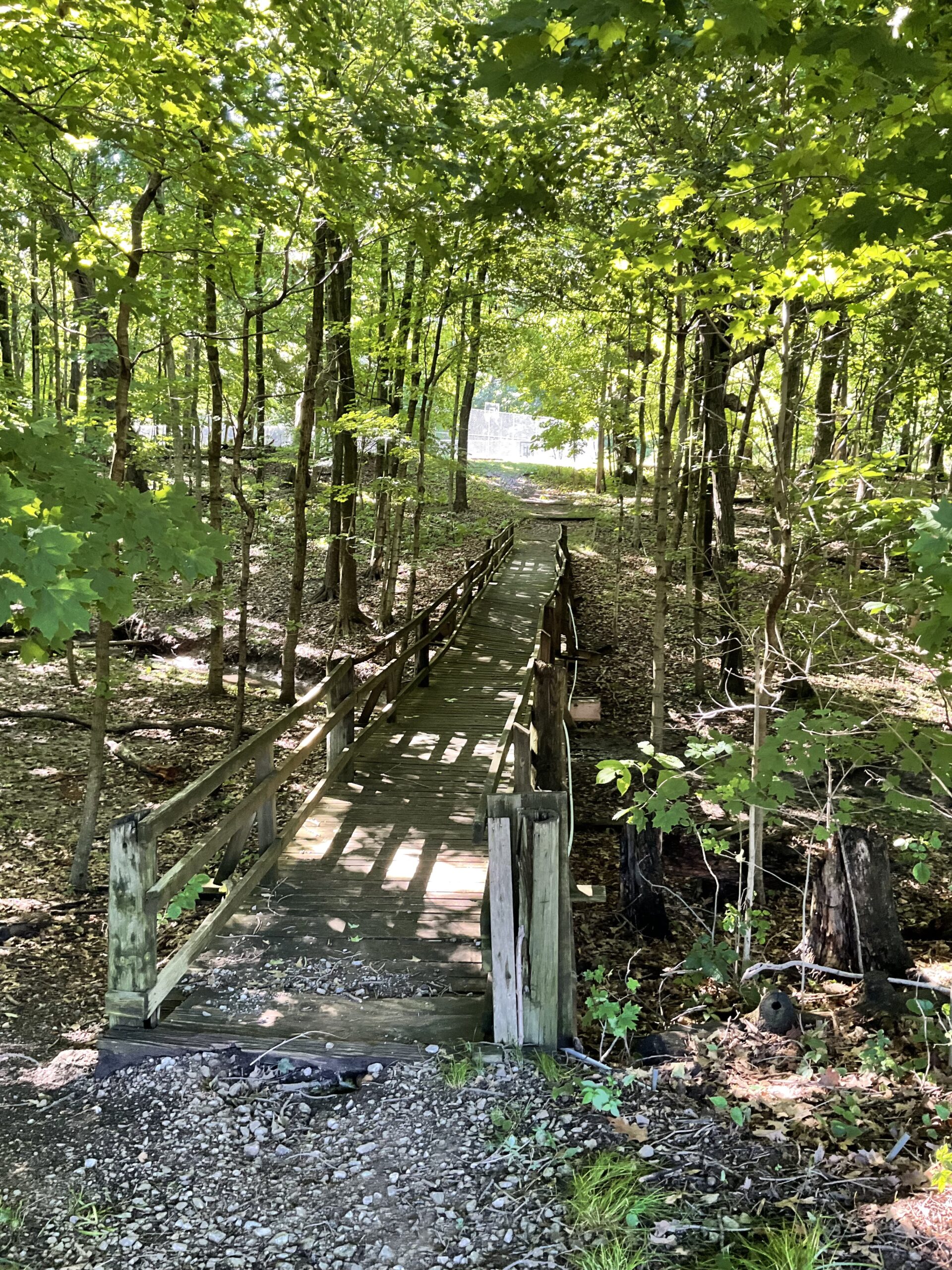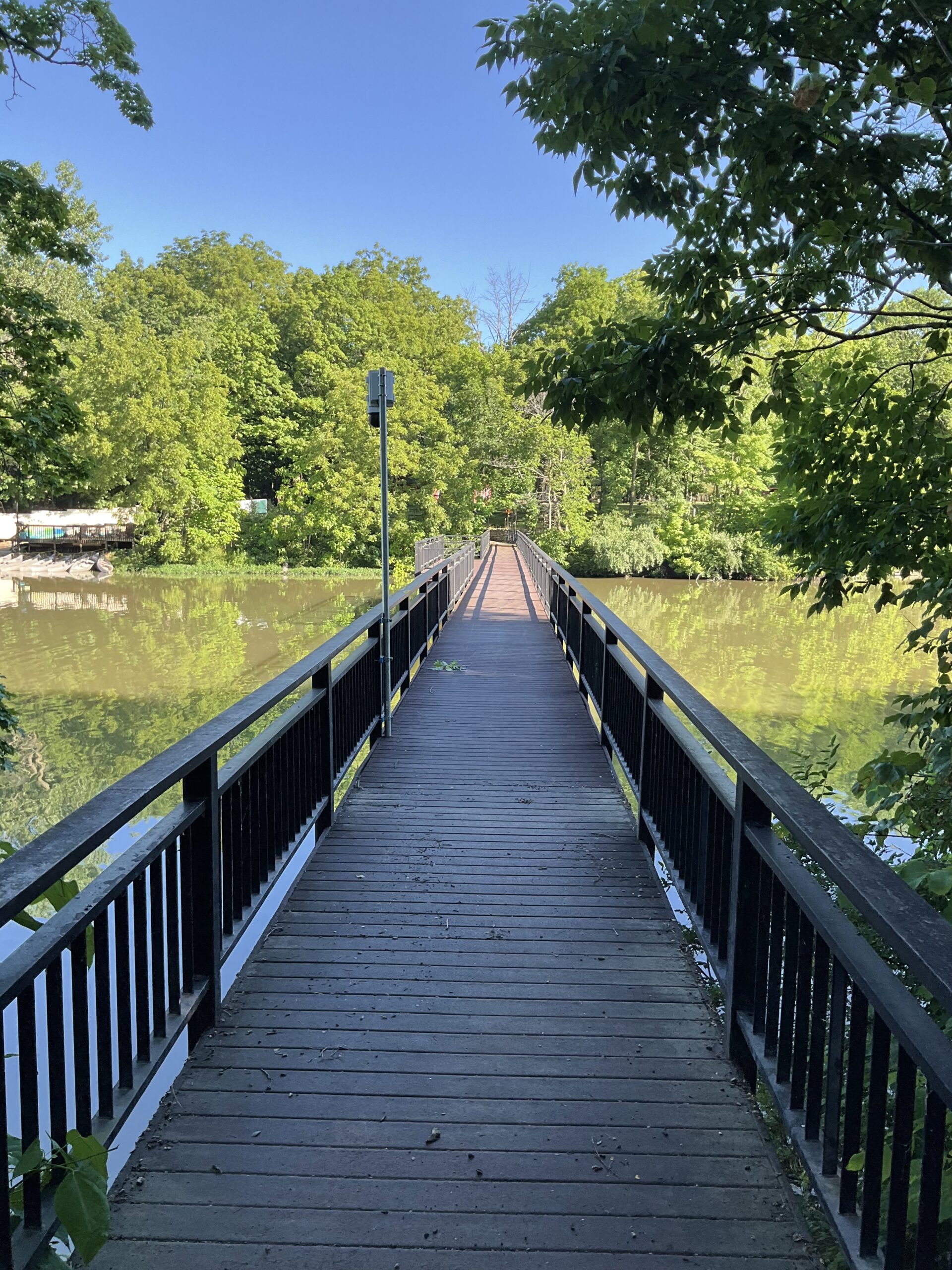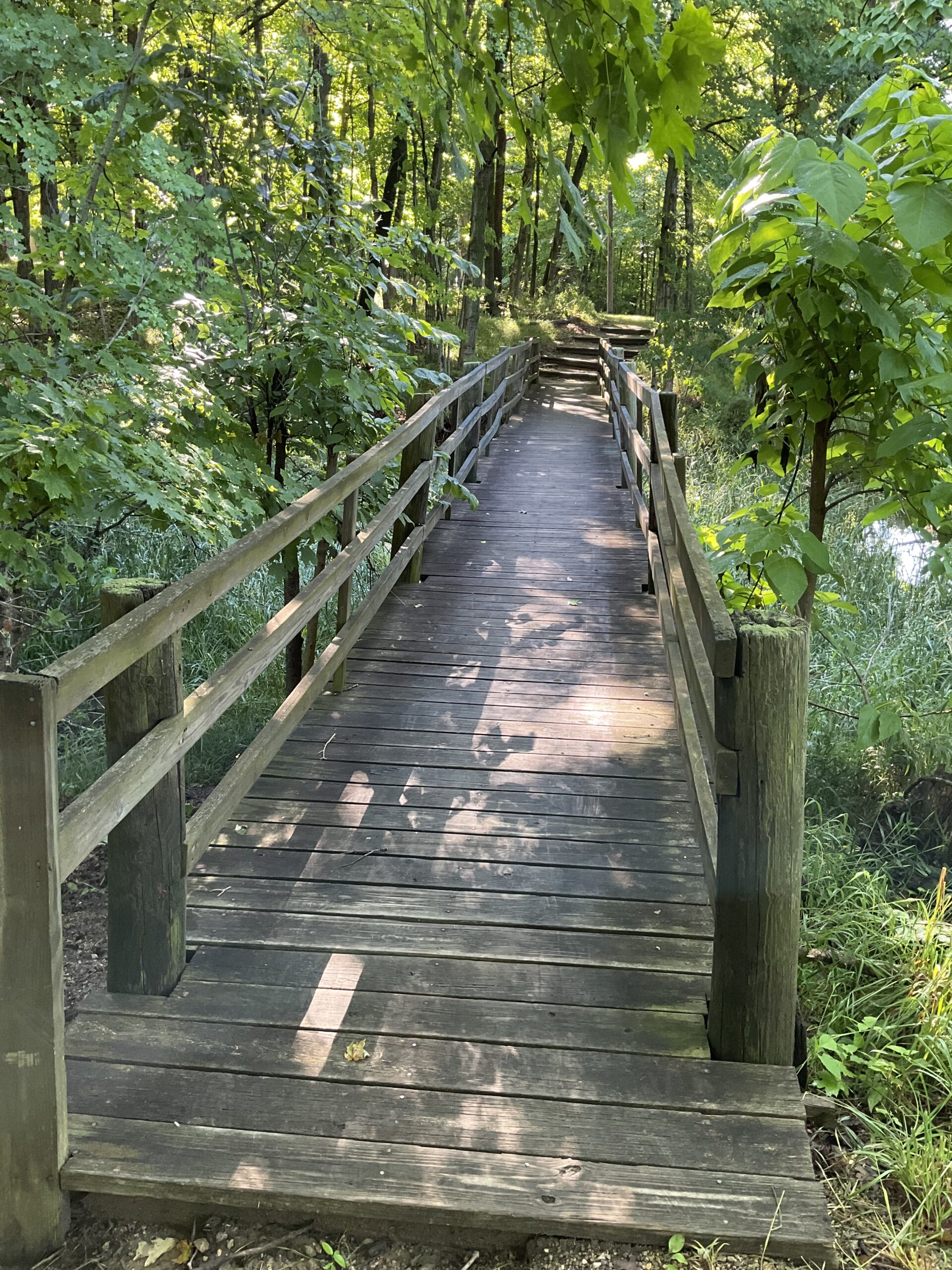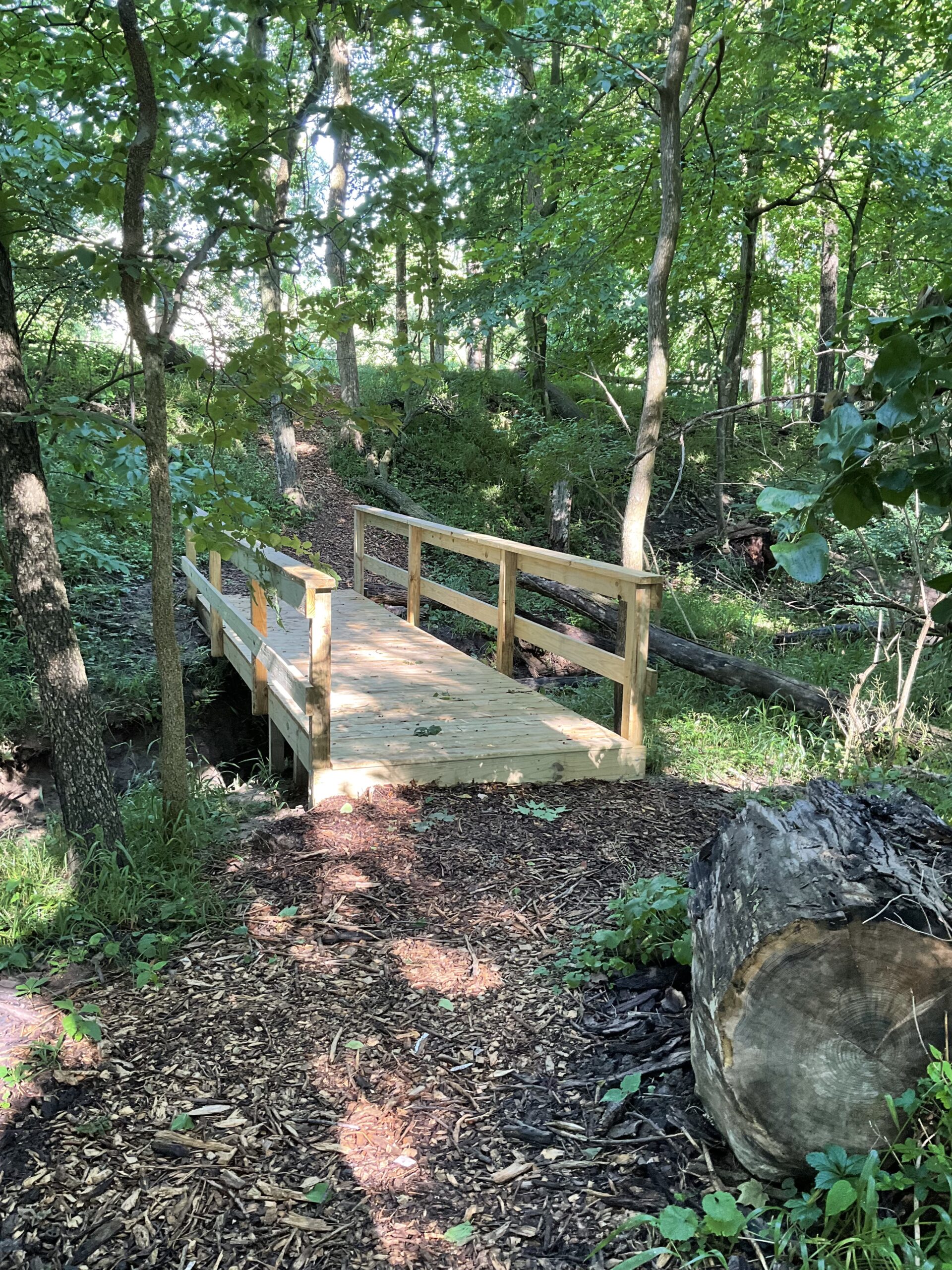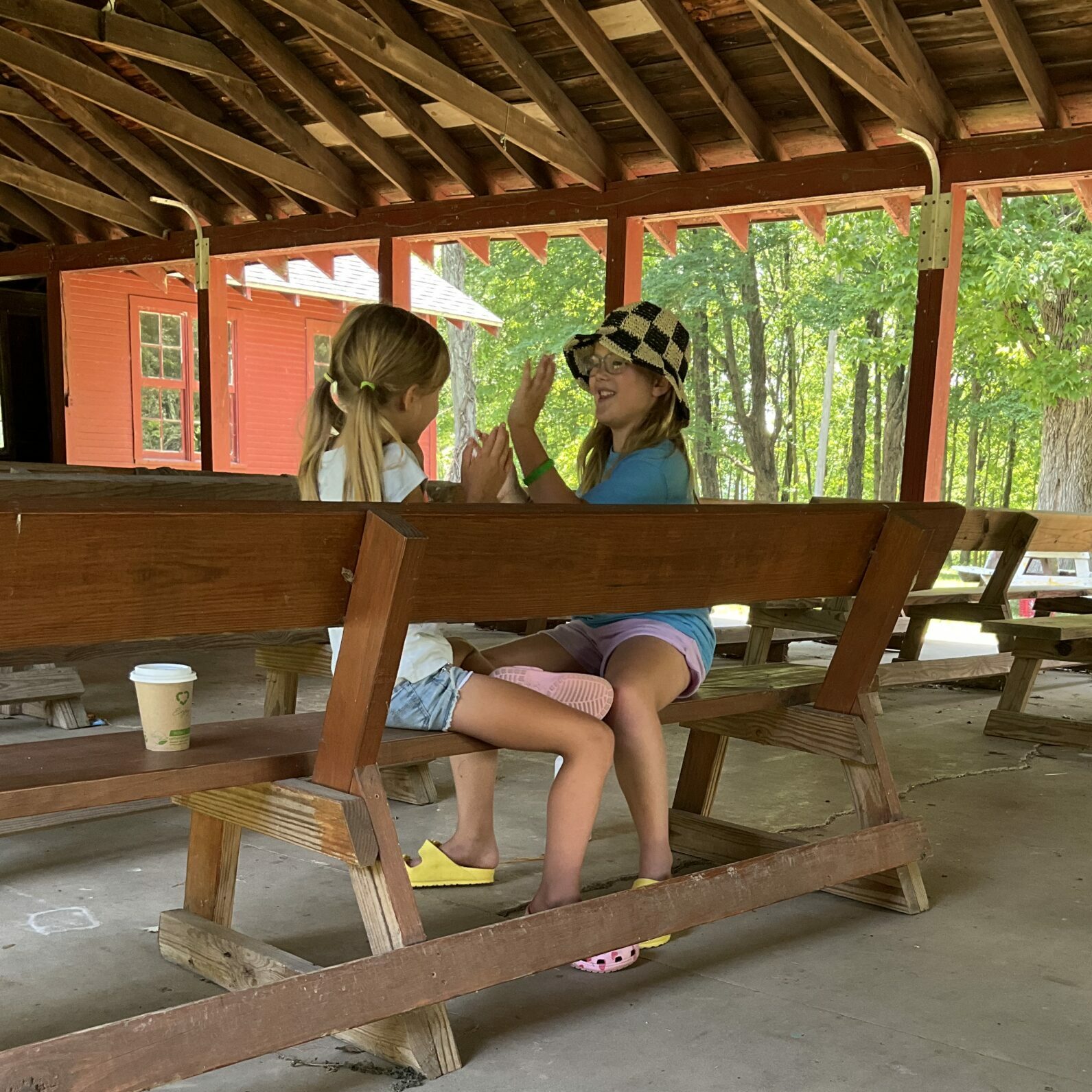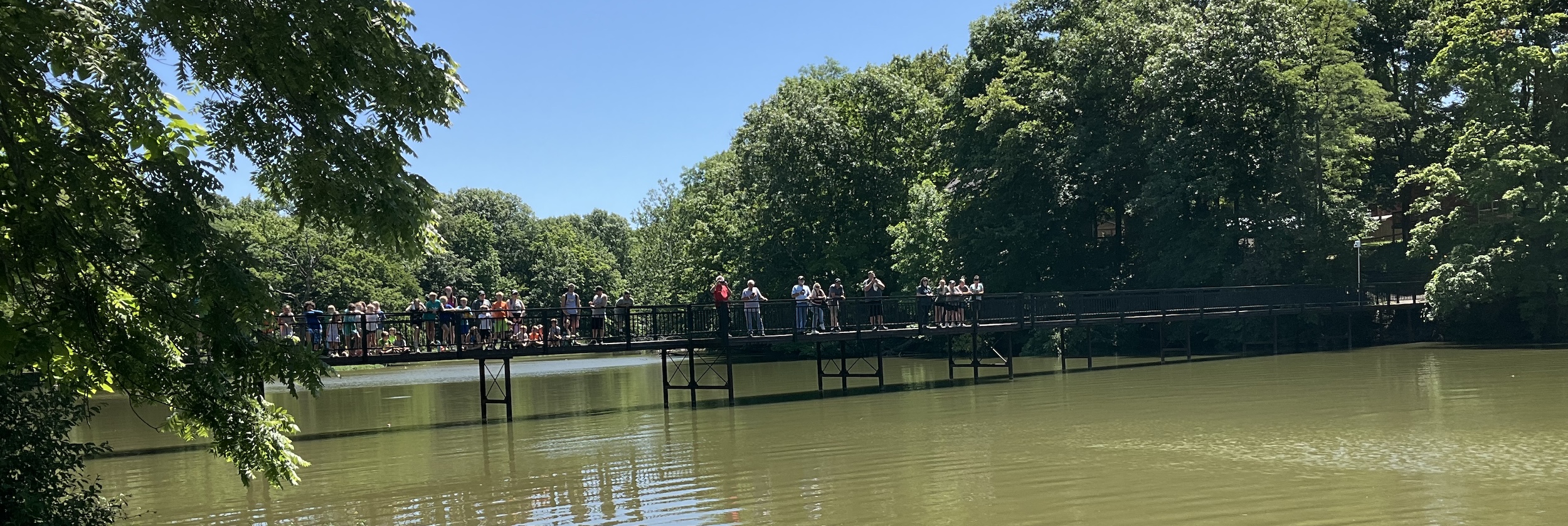As I perused the map and reflected on my tour of East Bay Camp, I was struck by how separate and yet how interconnected everything was. Each area of camp is distinct, serving unique purposes and with a unique story, and yet they are connected, both literally by foot bridges and figuratively in mission and purpose. During my time on site as part of the Rhythms of Faith Project, I had the opportunity to engage in activities, meals, worship, and devotional times with each of the distinct groups on site. Through interaction, observation, and intentional focus groups, I was able to gain a better understanding of how East Bay functions and the impact that it has on campers, families, and churches. It is a place of community and connection.
Getting Oriented: A Tour of East Bay
The road into East Bay camp is a two-lane highway that bends and curves with the land. At first all you notice as you drive are the large lake homes, but as you continue on, you begin to see signs of summer camp – dirt roads, large open spaces, and off in the distance, children running and playing. Unlike many camps where a long, quiet, dirt road leads you to the main office, arriving at East Bay involved a slight veer off the highway to pull into the main hub of camp, where the office, Pilchard Hall (a large dorm/conference style building), a dining hall, and the maintenance facilities are all located. While most of East Bay’s property is on the lake-side of the road, there are several interconnected sites on the opposite side of the road, as well. Large cross walks and large flashing lights mark the crossing zones that are essential to the flow of campers across the large site.
Upon arrival, I connected with the site director and, after a brief introduction to their staff, we headed over to the dining hall together. We saw a gathering of high school campers outside the dining hall singing their way through some classic camp pre-meal prayers before entering the dining hall together. As soon as they entered, another group, this one more intergenerational, lined up for lunch. This was a group of children, youth, and young adults, along with a few adult leaders, from a local Presbyterian church. They’ve been coming to East Bay for years, and this is their largest post-COVID group. Inside the dining hall, I was introduced to another group of campers, this one much younger than the rest. These day campers were finishing their lunch and heading back out for their afternoon of fun activities, armed with full bellies and full water bottles, to enjoy the sweltering heat in a way that seems only possible at summer camp. After a delicious lunch and conversation at the staff table, we embarked on a driving tour of camp, making use of the road that runs through it.
Like most camps, East Bay has a unique and rich history, and that history is evident in the geographical layout of the site, as well as the buildings that populate it. We started our tour on the western most edge of camp, at a place known as “Three Bears.” Three Bears is a large open space with towering trees and a beautiful lake side spot called “Inspiration Point.” Several unique buildings stand on the property, including a tower that was built many years ago through a close partnership with the neighboring boy scout camp. Next, we traveled to the far east side of camp and began to work our way back. The first stop was the “Woods” site, where the Presbyterian group was staying. It is more wooded than the other sites and has five cabins, each with bunks and bathrooms, as well as a central building that can be used for everything from meals to large group games (the favorite of this group is Mafia!). Adjacent to the Woods is a large building that houses East Bay’s indoor pool and gym, both of which are used by the community for birthday parties, swim lessons, and pickleball, in addition to being used by campers. Next, we visited the Aldersgate area, which has several renovated cabins and guest houses, as well as a large open space, and a pavilion style structure that is used for worship and general group gatherings. Next to Aldersgate is Maples, which is where Day Camp is run. Like Three Bears, Maples provides a large open space, but also has a pavilion, another dozen cabins, a counselor living area, and a bathhouse. On our way back to main camp, we stopped by one final area of camp, where a multi-sport court stands. Years ago, a large community center stood in this space and was a central hub for the Lexington, IL community.
Getting Connected: The Camp Experience
The primary group on site, and the one I spent the most time with, was a group called “Catch the Spirit.” This high school camp is an East Bay Camp but is one of two programmatic “remnants” from the Dean Model of Methodist camping, when volunteers directed the various summer camps in the conference. As such, it is uniquely run by clergy from local United Methodist churches. Catch the Spirit has a long and rich history at East Bay, and as a result, the main program team does not have a ton of control over its schedule, but the program’s leaders are passionate about helping teenagers catch the spirit of God in a way that transforms them for life. This year’s theme is “Find Your Voice.” Through Bible study, family group time, art, service, and campfire reflections, they are learning about how to find and share their voice in the world. In my focus group with campers, conversations about having your identity in God dominated their reflections on what they’ve learned through the faith formation sessions. For most of these teens, camp is an escape from difficult home situations and the many social pressures of middle and high school. However, some campers talked about how their experiences have impacted their families beyond camp. One camper, who has been coming for many years, shared about how after she attended for a few years, her family started to get more involved and began participating in missions’ weeks at camp. She also said that as a result of camp “my family has grown a lot with Christ, and going to church, and that’s just kind of what our family is based off of.” Another camper shared that camp has helped her learn how to “slow down and enjoy the little things in life.” She continued to talk about how when she gets home, she realizes how much she misses when she doesn’t take time to slow down, and tries to be more present in daily life. Finally, one camper shared that her time at camp made her “want to go to church” because “doing stuff at camp made me want to do more [at church and at home] because they teach us about God in a fun way – a way that we can understand.” Another camper agreed. She felt that at camp, there was a lot more room to explore faith and ask questions instead of “being talked at, which is a lot harder to engage.” A male camper talked about how living at camp provides a different rhythm for life. When asked directly about how camp impacts life at home, most campers shared about how they felt the impact was really more personal than familial. They talked about how camp impacted them, and in one case led to a personal decision for salvation and set them up for a new way of life rather than directly impacting their families.
When I spoke with some of their parents, it was clear that this camp plays a key role in resetting spiritual, mental, and emotional systems of their children each year. All the parents I spoke to attended churches with small youth communities, and camp provided a space to be around a lot of Christian youth to reinforce in more youthful ways what they are learning at home and at church. Parents also talked about the importance of “finding themselves,” “growing closer to God,” and getting prepared for other experiences like college. For them, the cultural alternative that camp provides plays a key role in their growth and formation. All the parents in the group had multiple years of experiences with East Bay under their belt, and all were in agreement that East Bay is a special place for their children and their families.
While I spent most of my time with this High School group, I was also able to interact and converse with the two other groups on site, Day Camp and the Presbyterian youth group. From conversations with Nancy and participation in the group, I learned that Day Camp is designed to meet three essential needs: child care, faith formation, and overnight camp pipelines. Through classic camp worship, fun activities, and a short but intentional devotional time, campers learn about Jesus while being cared for in a safe environment, and many go on to experience the deeper impact that comes through overnight camp. Along with the faith impacts, East Bay is providing an essential and critical opportunity to experience what many are calling the return to play-based childhood, and that alone can have important impacts.
When I first encountered the Presbyterian youth group during my first lunch in the dining hall, I could not help but notice the age range of campers, as well as the leadership of older campers towards the younger. Everywhere I looked, an older camper was intentionally helping a younger one fill their plate at the salad bar, and younger campers fought for seats next to the older ones. I soon learned that they intentionally structure their time at camp so that the older campers are able to have an overnight experience as well as a leadership experience with the younger campers attending only during the day time. The leader of that group, Kelly, talked with me about how helpful camp has been for fostering community across all the young people in their church, as well as for fostering leadership and responsibility, alongside faith, in her older youth. As I interacted with them, I found myself captivated by their model, and deeply appreciative of East Bay’s willingness to open their space to a church from outside their denomination to use the space in a way that best suited their needs. Like all camp models, this model of using camp has its pros and cons, but it was evident that for this group, camp accomplished its purpose: intergenerational faith formation and community development.
Building Bridges
On my last day at camp, as I walked around and reflected on my experience, I was struck by the intentionality of the foot bridges, and the ways in which the bridges serve as both an opportunity to disconnect, and an opportunity to connect. They allow for a seamless flow of groups and programs in and out of East Bay’s many properties and create points of essential connection. The high point of the last day was, without a doubt, the cardboard regatta that the Catch the Spirit group had been preparing for all week. I secured my spot on the beach a few minutes before it began and watched as all the groups on camp gathered on the main footbridge over the lake to watch the event. Several parents, many of whom were also clergy members, showed up to watch the event as well. The foot bridges provide a visual picture of who East Bay is – it is a camp of the community and for the community.
A brief read through an old history booklet confirmed my developing conceptions – East Bay has long existed as a space to serve a variety of needs across a variety of group types. This is one aspect that makes East Bay unique. Like the footbridges that intentionally link each site together, East Bay works hard to foster relational and experiential connections between churches, camper families, the surrounding community, and the camp itself. As evidenced by thriving relationships with neighbors, which both the director and the program director separately discussed, East Bay prioritizes authentic, Christlike connections at both the organizational and personal level (while I was there, the entire camp was under a water-boil advisory, and East Bay’s neighbors were key players in providing water to camp!).
Interestingly, the highway, though inconvenient, creates a sort of horseshoe shape that surrounds most of camp. When viewed aerially, the road looks like a boundary line that holds the many sites of East Bay together as a cohesive unit. The map itself is a metaphor for the community vision that East Bay holds. While they continue to work on improving their reach into families and integrating faith formation with the countless fun activities that campers participate in, they do so all with this vision of community and connection in mind. At the end of the day, whether you arrived for the first time or the twentieth time, on your own or as part of a group, one thing is for sure: you’ll leave as part of a community.
